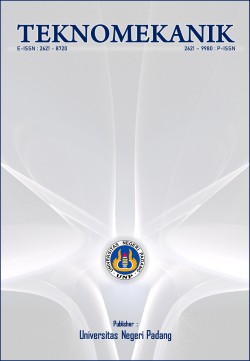Anticorrosive epoxy coatings enhanced with rice husk derived-graphene
DOI:
https://doi.org/10.24036/jptk.v5i2.26823Keywords:
Rice Husk, Graphene, Epoxy Resin, CorrosionAbstract
Coatings are the most common corrosion control practice. Therefore, it is very important to discover the most cost-effective and environmentally-friendly coating materials for sustainability. When dispersed in epoxy resin, graphene has barrier properties that improve the anticorrosive performance of the metal significantly. Graphene can be synthesized from agricultural waste. Herein, graphene derived from rice husk and epoxy resin was developed with solution mixing to prepare graphene-epoxy coating composites with enhanced anti-corrosive properties. X-ray diffraction, UV-vis spectroscopy, and scanning electron microscopy were used to characterize the synthesized graphenes. The anticorrosive properties of the coatings were characterized by potentiodynamic polarization and electrochemical impedance spectroscopy, which resulted in the corrosion resistance of synthesized graphene and commercial reduced graphene oxide being better than commercial graphene. The impedance and corrosion rate values of synthesized graphene are 1.77 x 105 Ω and 0.00011 mm/year.
Downloads
References
Ismail, M., Yusof, N., Yusop, M., Ismail, A., Jafaar, J., Aziz, F., & Karim, Z. (2019). Synthesis and characterization of graphene derived from rice husks. Malaysian Journal of Fundamental and Applied Sciences, 15(4), 516-521.
Kamal, A. S., Othman, R., & Jabarullah, N. H. (2020). Preparation and synthesis of synthetic graphite from biomass waste: A review. Systematic Reviews in Pharmacy, 11(2), 881-894.
Kausar, A. (2019). Corrosion prevention prospects of polymeric nanocomposites: A review. Journal of Plastic Film & Sheeting, 35(2), 181-202.
Mahato, N., & Cho, M. H. (2016). Graphene integrated polyaniline nanostructured composite coating for protecting steels from corrosion: Synthesis, characterization, and protection mechanism of the coating material in acidic environment. Construction and Building Materials, 115, 618-633.
Muramatsu, H., Kim, Y., Yang, K., Cruz-Silva, R., Toda, I., Yamada, T., . . . Saitoh, H. (2014). Rice husk-derived graphene with nano-sized domains and clean edges. Small, 10, 2766-2770.
NACE International. (2016). International Measures of Prevention, Application, and Economics of Corrosion Technologies Study. IMPACT.
Sharma, R., Chadha, N., & Saini, P. (2017). Determination of defect density, crystallite size and number of graphene layers in graphene analogues using X-ray diffraction and Raman spectrocopy. Indian Journal of Pure & Applied Physics, 55, 625-629.
Singh, P., Bahadur, J., & Pal, K. (2017). Onestep one chemical synthesis process of graphene from rice husk for energy storage applications. Scientific Research Publishing, 6, 61-71.
Thema, F., Moloto, M., Dikio, E., Nyawinge, N., Kotsedi, L., Maaza, M., & Khenfouch, M. (2013). Synthesis and characterization of graphene thin films by chemical reduction of exfoliated and intercalated graphite oxide. Journal of Chemistry(150536).
Wang, P., & Cai, D. (2020). Preparation of graphene-modified anticorrosion coating study on its corrosion resistance mechanism. International Journal of Photoenergy(8846644).
Yang, M., Liu, Y., Fan, T., & Zhang, D. (2020). Metal-graphene interfaces in epitaxial and bulk systems: A review. Progress in Materials Science, 110, 100652.
Yang, N., Yang, T., Wang, W., Chen, H., & Li, W. (2019). Polydopamine modified polyaniline-graphene oxide composite for enhancement of corrosion resistance. Journal of Hazardous Materials, 377, 142-151.
Yang, S., Zhu, S., & Hong, R. (2020). Graphene oxide/polyaniline nanocomposites used in anticorrosive coatings for environmental protection. Coatings, 10(1215).
Zhang, R., Yu, X., Yang, Q., Cui, G., & Li, Z. (2021). The role of graphene in anti-corrosion coatings: A review. Construction and Building Materials, 294, 123613.
Downloads
Published
Issue
Section
License
Copyright (c) 2022 Dinda Putri Amalia, Rini Riastuti

This work is licensed under a Creative Commons Attribution 4.0 International License.





